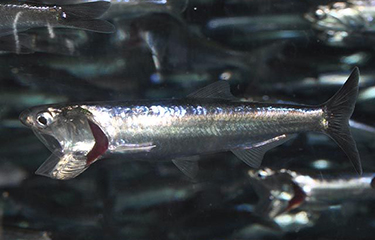New research analyzing 45 years of data has identified ecological correlations that may help explain why California’s anchovy population goes through boom and bust cycles, which have previously evaded scientific explanation. If the conclusions of the research hold up, they could provide a stronger baseline for management and conservation of the anchovy fishery in the Western U.S. state.
The Northern Anchovy (Engraulis mordax) is a critical food source for many of California’s iconic ocean species including sea lions, whales, dolphins, pelicans, and tuna. Its cycles of boom and bust can last more than a decade, and have broad implications for the entire marine foodweb in the region. The study found that shorter food-chains for anchovy larvae preceded boom periods and longer food chains preceded bust cycles.
The study’s lead author, Rasmus Swalethorp, an associate project scientist at University of California, San Diego’s Scripps Institution of Oceanography, said he believes the reason for this correlation is that shorter food chains are more efficient than longer food chains, resulting in more energy from the base of the food chain reaching the anchovy larvae.
“It’s analogous to the energy loss that occurs when electricity goes from the power plant to our homes – the longer the distance, the more energy gets lost along the way,” Swalethorp said. “That’s how it is going from one level of a food chain to the next – the more steps, the less energy gets to the anchovy larvae. The larvae could be eating the exact same foods but when the food chain elongates it may mean food is less plentiful or that the same foods don’t contain as much energy.”
The study, published December 5 in Nature Communications, was funded by NOAA and the National Science Foundation and used decades of data from the CalCOFI research program, which surveys California coastal marine ecosystems in one of the most extensive ocean monitoring programs in the world. These surveys found that shorter larval food chains have fewer steps between the photosynthetic phytoplankton harvesting the sun’s energy at the base of the food chain and the food consumed by anchovy larvae, mostly zooplankton. The research infers shorter food chains have the ability to support more individual larvae.
The research used the CalCOFI’s sampling program to better understand the mechanisms underpinning the rises and falls of anchovies in the California Current Ecosystem. Researchers used stable nitrogen isotope analysis to determine food chain length for 207 approximately three-week-old anchovy larvae collected by CalCOFI between 1960 and 2005.
“The ocean is a very big place and our ability to sample it in a way that’s representative is very limited,” Swalethorp said. “CalCOFI is the most comprehensive ocean ecosystem survey on the planet and it’s the best shot we have at getting at these bigger ecological mechanisms.”
Swaelthorp said the team is beginning to probe the complex questions of what other species are in the food chain and who is eating whom when the food chains elongate and how these cycles are triggered at the base of the food chain. Beyond this, the results of this study will be further tested when the researchers attempt to apply it to other regions and other species of fish such as the Peruvian anchoveta (Engraulis ringens) – the single largest fishery by volume in the world.
Forage fish such as anchovies and sardines are some of the most abundant exploited species in the sea and provide vital food security through direct human consumption and their use in aquaculture feed, at a low environmental impact compared to most other methods of food production. However, concerns raised by the scientific community that forage fish harvesting can have harmful impacts on predators have called into question the sustainability of the fishery, according to University of Washington School of Aquatic and Fishery Sciences Professor Ray Hilborn. Hilborn has disputed the methods of previous studies on forage fish, finding that stocks appear to be less influenced by fishing effort than food availability and other natural factors, and has suggested that more and better research is necessary before sound policy advice can be given for the management of forage fish fisheries.
Photo courtesy of U.S. Geological Survey







